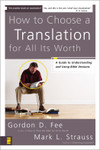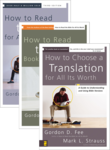We have three new modules available in Accordance from Zondervan’s “How to” series. These books are great resources for those interested in getting the most out of their Bible study.
How to Choose a Translation for all its Worth: $15
I was recently asked in an Accordance seminar about which Bible translations I recommend. My typical answer is that I recommend using at least two or three Bible translations that are based on different translation philosophies, meaning that you want at least one literal translation (word for word) and one dynamic translation (meaning for meaning). Literal translations attempt to use one English word for each original Greek or Hebrew word in the original manuscripts. These translations make it much easier to study the Bible using Strong’s numbers, since there is usually a word in the original language that lies behind each word in your English Bible. So why do some scholars believe a literal translation philosophy is the wrong approach? The challenge is that languages are not 1:1. Sometimes, the original Greek or Hebrew word used in a manuscript does not have an ideal corresponding English word that perfectly conveys the nuance of that word. This is when dynamic translators attempt to find a cluster of English words that more closely captures the meaning of the original text. This isn’t just the case for words, but also for phrases. When you add to this the challenge of translating documents that were written hundreds/thousands of years ago, you can see how the task of translating the Bible is quite challenging.
How to Choose a Translation for all its Worth takes the mystery and confusion out of this process and explains in everyday language the different translation philosophies. It also discusses some of the popular translations available today and highlights their potential strengths and weaknesses. If you want to know more about which modern translations are literal, which are dynamic, and why the translators made the choices they did, this book is right for you.
How to Read the Bible Book by Book: $24
Reading the Bible book by book always sounds like such a noble goal, doesn’t it? You start out with the best of intentions on January 1. You’ve failed in the past, but this time will be different. This time…you are determined. You start in Genesis and things couldn’t be going more smoothly. The exciting narratives of Abraham, Isaac, and Jacob have captured your attention. Joseph keeps you on the edge of your seat with his incredible dream-decoding skills and his dazzling coat of many colors. Exodus starts out just as smooth with a burning bush that reminds you of that time you watched Prince of Egypt in IMAX. The law in Exodus 20 gets a little more challenging, but you are determined to stay focused. You are a rock. Then something happens. Somewhere between the detailed instructions for the tabernacle and Levitical law you start losing momentum, and by the time you come across the first list of kings’ names that you can’t pronounce, you decide to take a break, just for a couple of days. Before you know it, you’re totally off the wagon and trying to convince yourself that watching Mel Gibson’s The Passion basically gives you the gist of the New Testament.
Many of us have have tried reading through the whole Bible and many of us get stuck at some point. How to Read the Bible Book by Book is a guided tour through the whole Bible from Genesis to Revelation. While it’s focus is not necessarily on reading the whole Bible chronologically or canonically, it will certainly aid those who wish to use it for this purpose. For each book of the Bible, the authors start with a quick snapshot, then expand to help you understand the deeper meaning and context behind the text. This will allow you to approach each book of the Bible on its own terms, understanding the unique purpose and intention of the authors. If you want to read through the whole Bible, or if you want to know more about the particular book you are currently studying, How to Read the Bible Book by Book is for you.
How to Read the Bible for all its Worth: $22
Have you ever wondered why some books of the Bible are written in a completely different style than others? When I was a young, this was particularly confusing for me because I thought the Bible was one big book. When I came to realize that the Bible is a compilation of books written over hundreds of years by different authors with a variety of goals, it seemed fairly obvious that they would be written in different styles and genres. However, it can be challenging to know how these stylistic differences should influence and inform the way we read the Bible. This is where How to Read the Bible for all its Worth comes in. Writing in a conversational tone, the authors explain how to read the Bible in way that takes into account the genre and style of the authors. If you’ve ever read a Psalm followed by a chapter in Proverbs followed by one of Paul’s letters, you know how valuable this information will be. How to Read the Bible for all its Worth will help you understand the Bible in a whole new light.
Each of these books stands on its own, but together this set is fantastic.
See the Blog post.





